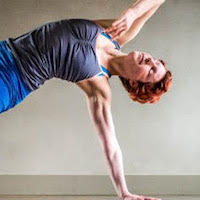Editor’s Note: This website is not designed to, and should not be construed to, provide medical advice, professional diagnosis, opinion or treatment to you or any other individual, and is not intended as a substitute for medical or professional care and treatment.
I am often on the fence about instructing or encouraging students (or myself in my own practice for that matter) to ‘bind’ in postures or not.
‘Binding’ in a Yoga posture is when we wrap our arm or arms around our torso or leg and then clasp on to either our opposite hand or perhaps foot. As binding takes time and a certain level of openness in the joints it is not for beginners, but body proportions and limb length can also dictate how accessible it is for different students. Hyper mobile people or those with longer limbs will just find it easier to get into.
Sometimes I feel people opt ‘to take the bind’ as a rite of passage, a next level achievement that they seek out at all costs. I sometimes have to strongly encourage people to take several steps (kramas) back when they forsake relaxed shoulders, the integrity of the spine and shoulder girdle, and smooth breath in order to clasp their hands together tightly around a part of their body in some way.
If I am totally honest I have been guilty of this too, ( ‘just one more centimetre, if I could just reach, there’s my finger, nearly there…sooo close!). But why do we want to do it and why (as I am hoping to address in this article) does it in fact feel so good afterwards?
Is the reason we should bind not to get deeper into postures but for the intense compression and then subsequent wondrous feeling of relaxation when the bind is released?
Research has shown that deep pressure massage helps with relaxation (1). It’s why hugs work, and actually why some children on the Autistic spectrum with sensory needs find weighted blankets and vests so comforting and necessary to help them relax.
Pressure on the muscles, like that we receive in a hug or from deep pressure massage, trigger the body to release certain ‘happy’ hormones. Two of which I will introduce below.
Oxytocin
Oxytocin is the magical hormone that is released during childbirth. It is what helps our mothers forget the pain they endured and makes them still want to love and care for us. When we hug someone or receive a massage, oxytocin is released into our bodies by our pituitary gland, lowering both our heart rates and our cortisol levels (2). Cortisol is the hormone responsible for stress, high blood pressure, and heart disease. Amazing!
Dopamine
In addition to releasing Oxytocin, hugs and massage also stimulate the brain to release dopamine, the pleasure hormone (3). Dopamine sensors are the areas that many stimulating drugs such as cocaine and methamphetamine target. So hugs, or deep pressure massage on yourself can help the body release hormones to bring a sense of pleasure and wellbeing over your whole system.
In The Journal of Child and Adolescent Psycjopharmacology (Volume 2, Number 1, 1992), Mary Ann Liebert, states:
“The Deep muscular pressure is also beneficial to normal development in babies. Institutionalised babies who received additional tactile stimulation, mainly deep touch pressure, developed more normally. Premature babies who receive stroking and tightly bound swaddling also are reported to show definite benefits. (4)
The strong need for this kind of deep touch is explored in Harlow and Zimmerman’s classic experiment (1959) where “baby monkeys would cling to and press against a soft cloth mother surrogate which provided contact comfort, over a wire surrogate that provided milk.”( 5)
Mary Ann Liebert in the same journal publication mentioned above, also goes on to state that
“Deep touch stimulation is beneficial to normal babies. Institutionalized babies who received supplemental tactile stimulation, mainly deep touch pressure, developed more normally. Premature babies who receive stroking and tightly bound swaddling also are reported to show definite benefits.” (6)
So hugs and deep pressure massage both release positive, happy, calm inducing hormones into the body.
To bind or squeeze our own limbs in to our torso is a bit like giving ourselves a hug or a deep pressure massage. I think if we treat binding in yoga asana as a massaging, full body compression hug and pay attention to the feelings we receive after the bind has been released then we can view it as a way towards deeper relaxation and wellbeing, not as a way to push or pull ourselves further into postures.
*
Endnotes:
1. Alternative Therapies, NOV/DEC 2012, VOL. 18, NO.6.
2. Field, Hernandex-Riei, Diego. CORTISOL DECREASES AND SEROTONIN AND DOPAMINE INCREASE FOLLOWING MASSAGE THERAPY.
3. ibid
4. The Journal of Child and Adolescent Psychopharmacology Volume 2, Number 1, 1992 Mary Ann Liebert, Inc ( http://www.grandin.com/inc/squeeze.html )
5. ibid
6. ibid
Additional references:
Love elephant and want to go steady?
Sign up for our (curated) daily and weekly newsletters!
Author: Hermione Armitage
Editor: Renée Picard
Photo: Google images labelled for reuse









Read 5 comments and reply